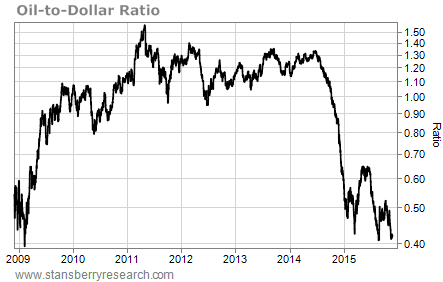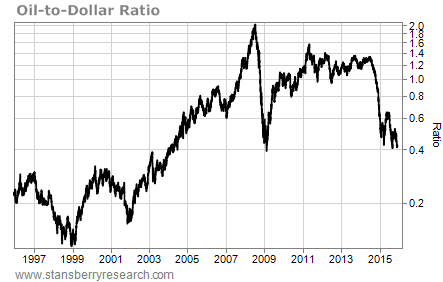The very ugly oil-dollar ratio
By Brian Weepie, Growth Stock Wire:
There’s a rare extreme in the oil sector right now. The oil-to-U.S. dollar ratio, which reflects the relationship between the price of oil and the dollar, is near its lowest point in almost seven years.
When this ratio hit a low in 2009, the price of oil went on to soar 214% to its peak in June 2014. But if you think this extreme means oil prices could soon rally, you’re making a mistake…
As regular readers know, the dollar has broken out over the past year. It’s now stronger than it has been since 2003 versus other major currencies. The U.S. Dollar Index is up 40% since it bottomed in 2008. Historically, when the dollar rises, commodities like oil tend to fall. This is what we’ve seen this time around. The price of benchmark West Texas Intermediate (WTI) crude oil is down more than 60% since June 2014 – to around $40 per barrel.
As a result, the ratio between the price of oil and the dollar has fallen. It’s down around 68% since oil peaked.

For this ratio to return to its normal level of the past few years, the dollar would have to fall significantly or oil prices would have to rise. But the above chart only tells part of the story. Take a look at this longer-term chart of the oil-to-dollar ratio:

As you can see, while the oil-to-dollar ratio is approaching a nearly seven-year low, it can fall much further. In December 1998, this ratio bottomed at 0.11. That’s more than 70% below today’s levels. Oil cost $10.72 per barrel back then.
I’m not saying oil is going to go back to those levels, but the oil-to-dollar ratio is trending lower. The last time this ratio spiked, global demand for oil exceeded supply. We aren’t seeing that today. In fact, we’re seeing the opposite. According to the International Energy Agency (IEA), the global oil supply exceeded demand by 1.6 million barrels per day in the third quarter. This oversupply is keeping oil prices low.
And the Federal Reserve is expected to raise interest rates at its December meeting. This will likely cause investors searching for yield to move into the dollar and push it higher… while pushing oil prices lower. If the ratio fell to its 1998 low, the price of oil would be at $11.40 per barrel.
Now, in the short term, we could see oil prices spike. Tensions are escalating in the Middle East. Turkey shot down a Russian warplane on the Turkey-Syria border on Tuesday. Vladimir Putin called the act a “stab in the back that will have serious consequences” for the relationship between the two countries. More fighting in this area could cause oil-supply disruptions that will lead to lower oil production… and push up prices.
But short-term events like this won’t stop the longer-term oil-to-dollar ratio downtrend. I’d consider lightening your oil and gas positions for the time being. There are likely lower oil prices ahead. By Brian Weepie, Growth Stock Wire:
OPEC’s Battle and Cheap Money. Read… Why the Price of Oil is Doomed for Longer than Expected
Enjoy reading WOLF STREET and want to support it? You can donate. I appreciate it immensely. Click on the beer and iced-tea mug to find out how:
Would you like to be notified via email when WOLF STREET publishes a new article? Sign up here.
![]()


Oil per dollar value should presently be priced at (Ready??) $28.60 bbl.
Get ready for the next leg down! Yes, that will cause some destruction to sunk assets in multiple ovations (too bad). Speculative investment is just that -speculative. Sometimes you win sometimes you lose.
Let Yellen begin normalizing rates here on Dec 16th, and the accelerated destruction in the EU, Canada, and elsewhere will follow.
I read that even more oil supply is set to come onto the world market next year with Iran oil coming online and a big play in Kazakhstan coming online. Meanwhile everyone else is still pumping like mad. Oh, and a whole bunch of folks around the world are sounding alarm bells about climate change and the need to move to clean energy sources.
Things that make you go “hmmmm….”
Well, with lower oil prices, Saudi Arabia and Venezuela will need to pump more oil to try to keep their financial heads above water.
I’m sure it will be fine. Or at least entertaining.
Saudi will have to tighten up (maybe put the 1500 princes on an smaller allowance) but they can keep their heads above water a lot longer than the frackers. The big question about them is which banks they are going to take down with them.
The IMF just released a report, Saudi has cash reserves to keep prices beow $40 until 2020. US companies are currently spending almost every operating dollar on debt service, and they’re hedges are running out too.
Saudi has $650 billion, Russia has around $350 billion…. we’ll see who cracks first. ;)
…and US of A has zero dollars and very tired printing press.
Interesting post that highlights what could be the next phase of the present oil wars between Saudi Arabia and Russia (the two largest oil exporters).
Russia has been able to increase her own market share in both Europe and especially Asia partly by increasing production and partly by allowing the ruble to be thrashed on currency markets.
So far the Saudi have contented themselves with increasing production and the riyal has stayed where it has been since 1986 (!) apart from a very brief spell in 2007: 0.26 to the dollar.
But with Russia chewing through their market share and European oil companies already in Teheran, I am sure the Saudi are at very least considering a “controlled” devaluation of the riyal. Sure, this will open a new can of worms: apart from oil and construction materials Saudi Arabia imports almost everything from abroad, especially food.
There’s no need to remind how important are stable if not subsidized food prices through the Muslim world: the Arab Spring catalyst were rising flour and bread prices.
And the House of Saud relies on a mixture of carrot and stick to stay in power.
The end of the dollar/riyal peg or even a controlled devaluation to, say, 0.22 could have interesting consequences on oil prices.
Just remember, the last time the bad guys lost, the citizens bailed them out:
“Citigroup Inc., Goldman Sachs Group Inc., UBS AG and other large banks face tens of millions of dollars in losses on loans they made to energy companies last year, a sign of investor jitters in a sector battered by the oil slump.
The banks intended to sell the loans to investors but have struggled to unload them even after cutting prices, thanks to a nine-month-long plunge that has taken Nymex crude futures to their lowest level since 2009.
The losses mark a setback for Wall Street, after global banks earned $31 billion in fees over the past five years by financing energy-company stock sales, borrowing and mergers-and-acquisition transactions, according to Dealogic.
Wall Street’s losses on the loans could have a chilling effect on some oil companies’ ability to fund their operations as investors take a more cautious view of the sector.”
Yes, the freaking banks again, life sucking entities. Cautious investors! Try and get your money out now, good luck with that.
http://www.zerohedge.com/news/2015-11-27/cusp-staggering-default-wave-energy-intelligence-issues-apocalyptic-warning-energy-s
Cheers.